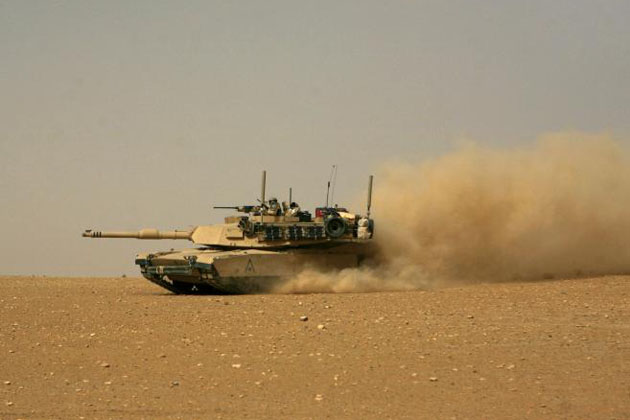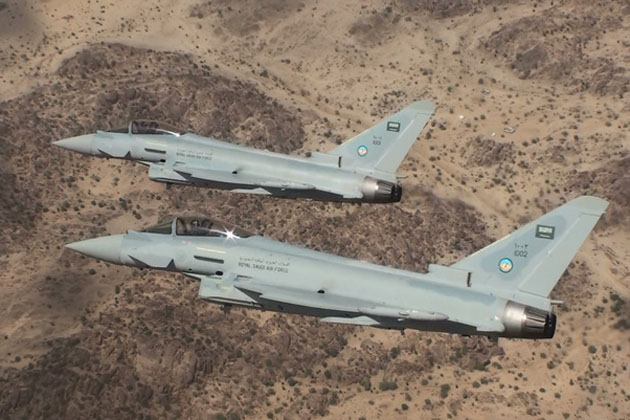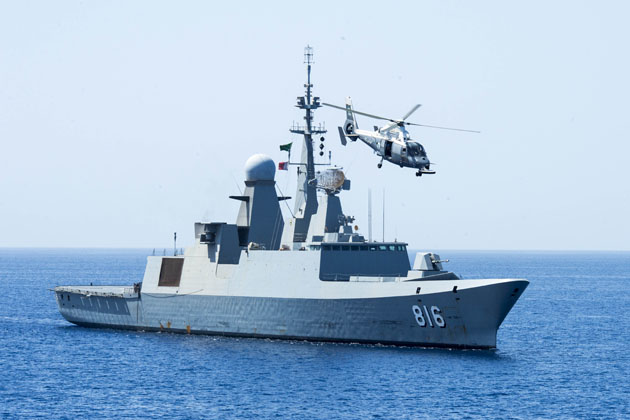Analysis: Saudi Arabia - A close customer (part 2 - air)
As we have already seen in
Part 1 – Land, the close defence relationship between Saudi Arabia’s ruling House of Saud and Western governments is built on a series of huge contracts for new and upgraded tanks and armoured vehicles that makes the Saudi land forces the most modern in the region.
But the money spent on ground equipment is chicken feed compared to that spent on the air force. The helicopters, fighters and bombers and the transport aircraft bought from the US and Europe far exceed the land and
maritime domains and is where the relationship is closest with industry.
On 13 December, Saudi Arabia recieved its
first four of 152 upgraded Boeing F-15SA (Saudi Advanced) fighter jets, which illustrates this neatly.
But, the most high profile in recent years has been the procurement of fast jets, particularly when the Royal Saudi Air Force (RSAF) selected the
Eurofighter Typhoon multi-role fighter to replace Tornado and supplement its existing fleet of US-built F-15C/D fighters.
These Typhoons were taken from a batch that was due to be delivered by BAE Systems to the UK Royal Air Force so it shows the
priority given to the Saudis. The initial was deal signed in 2007 for 72 aircraft at a cost of $8.86 billion to be delivered in three batches (three sets of 24). As of this year the second batch was delivered with the third underway. BAE is in negotiation for a further 48 aircraft but concerns over human rights have strained relations and it is unlikely to go through.
However, in 2012, BAE Systems secured a $2.5 billion contract for training aircraft including 22 Hawk, 55 Pilatus PC-21 aircraft, simulators and support, with the Hawk deliveries due to start this year after the PC-21s are completed. The company is also providing Cirrus SR22 aircraft as part of the deal.
Elsewhere upgrades to existing fighter aircraft remain the most lucrative for industry. The RSAF wants to keep some 84 Tornados in service until 2025 and includes the aircraft and supporting weapon and electronic systems. Stage three of the upgrade was signed in 2014 and is worth $2.5 billion to BAE Systems.
Raytheon is providing its Paveway IV bombs,
MBDA its Storm Shadow munition and Thales Damocles pods.
The biggest deal however was announced in 2010 with a $60 billion aircraft deal between the US and Saudi Arabia. The largest section of this deal was signed in 2011 in a contract worth $29.4 billion for 84 new
Boeing F-15SA Strike Eagle aircraft and also included upgrades to the existing fleet. The arrival of the first four aircraft on 13 December included two new build F015SA and two upgraded F-15S. The RSAF already has 59 F-15C, 21 F-15D and 68 F-15S aircraft.
The older F-15s were already being upgraded with new datalinks (under an earlier contract for $34.8 million to
Data Link Solutions, which is a joint venture between BAE Systems and
Rockwell Collins, in 2007) and engines (in contracts with
GE Aviation worth a total of $750 million in 2007-08), but the new deal has led to a spate of new contracts.
In 2012 Goodrich - now
UTC Aerospace - received $183 million for pods and logistics support, BAE Systems $367 million for electronic warfare systems, Boeing $18.4 million for the integration of eight pods. In 2013 the contracts included $253.4 million for Lockheed Martin for undisclosed work with a second contract worth $21.4 million for targeting pods that is part of
a longer term pod contract worth about $220 million. Raytheon got three contracts totalling $33.4 million for electronic and software systems but overall Boeing has secured $3.5 billion for conversion kits for the modernisation of the 68 F-15S aircraft to SA standard.
Saudi Arabia is also in a process of modernising it helicopter fleets and has a healthy inventory of western attack, multirole, utility and light helicopters.
In a 2010 deal, Saudi Arabia is acquiring 60
Apache AH-64 Block III helicopters and associated weapons in a deal worth $9.7 billion. There are 10 for the Saudi Royal Guard, 24 for the Royal Saudi Land Forces and 36 for the Saudi Arabian National Guard (SANG) – the royal family’s second army used for internal security.
Deals announced by the US DoD in 2013 shows that one Apache contract was valued at $333 million so far with others valued in the tens of millions.
Boeing has upgraded 12 Apache AH-64A attack helicopters to the ‘D’ standard for about $400 million, this likely to be for the SANG and includes a sights contract with Lockheed Martin worth $66.6 million awarded in 2012. This followed a $15.3 million contract the previous year. The Royal Saudi Land Force has been taking deliveries of the AH-64E ‘Guardian’ variant from Boeing and
Lockheed Martin secured a contract last year to provide target acquisition sights for this variant for $10 million.
Meanwhile Boeing is
providing SANG with 24
AH-6i Little Bird light attack and reconnaissance helicopters under a $234.7 million contract announced in 2014, although there has been a delay and deliveries have yet to take place.
In 2008 22 UH-60L Blackhawks were acquird for $286 million but now a total of 24 have been purchased. In 2010 as part of the $60 billion aircraft deal the
acquisition of 72 UH-60M transport helicopters was also included, 24 of which will go to the SANG with 16 delivered so far. The latest contract announced on 30 September was for $91.8 million for Sikorsky to deliver eight helicopters.
Sikorsky has business elsewhere and is upgrading 12
S-70A Blackhawk multirole helicopters to the L variant for an estimated $60-80 million and is delivering 10
MH-60R naval helicopters for the Royal Saudi Naval Force for $145 million. This is part of a deal worth a total of $1.9 billion, which was announced in 2015 and also includes a host of electronic, sensor and weapon systems worth $11.8 million for
SAIC, $66 million for Raytheon and Lockheed Martin $117 million.
MD Helicopters has provided 12
MD 530F training aircraft to SANG for $40.7 million that was completed in 2013.
For transport aircraft, the RSAF wants to replace its ageing C-130E transport aircraft. A FMS request for new and upgraded C-130s was announced in 2012 worth $6.7 billion. Contracts will be awarded in increments and Lockheed Martin has so far received $181 million and $662 million in 2013 and 2015 respectively for C-130 work. The first two
KC-130 were
delivered earlier this year.
Saudi Arabia is also buying eight An-132 and 30 An-178 transport aircraft from Ukraine’s Antonov some of which will be built in-country under an
agreement with Saudi state-owned company Taqina Aeronautics. Sub contract agreements have been signed this year with Pratt & Whitney for engines and Liebherr Aerospace for air management systems with, Esterline CMC, Hamilton Sundstrand, Honeywell and Broetje-Automation involved. The value of both could total about $90 million.
The air force is upgrading its five
E-3A airborne warning and control aircraft under three major contracts. The largest and most recent is the Block 40/45 avionics modernisation programme worth up to $2 billion announced in 2014. This follows a radar and command and control systems upgrade worth up to $400 million, first announced in 2007 and due to finish this year from which Boeing has been awarded a succession of contracts worth a total of at least $260 million with
Northrop Grumman as a major sub-systems contractor. Communications terminals were added from 2007-09 by Boeing and Data Link Solutions for $49.2 million.
The RSAF also bought a
Saab 2000 Erieye early warning and control aircraft from Saab in 2010 for $667 million that was delivered in 2014.
Other recent aircraft acquisitions include a number of
Beechcraft King Air 350i light transport aircraft modified by Raytheon for use for intelligence, surveillance and reconnaissance. They are being fitted with ISR equipment worth up to $257 million. The RSAF also bought three
MultiRole Tanker Transport aircraft from
Airbus from 2013-2016 for a reported $500 million.
The operation of a modern and well-funded air force makes Saudi Arabia a major regional power. By purchasing the latest aircraft, weapons, sensors and computer systems from Western suppliers the Saudi regime is making some powerful friends and is becoming an invaluable customer. The purchase of expensive naval platforms and upgrading of existing ships only adds to this breadth of western industrial involvement, see part 3 - the
maritime domain here.
Until recently Saudi Arabia has avoided military operations but it is becoming more openly proactive rather than just working behind the scenes. By flexing its muscles in Yemen alongside its backing of some rebel groups in Syria it is becoming a more uncomfortable relationship for Western governments and industry to manage.
Analysis: Saudi Arabia - A close customer (part 3 - maritime)
We come to the last part on Saudi Arabia’s defence relationship with the West, the maritime domain. This is less high profile than the
land and
air but naval platforms have a high dollar price tag and require just as significant an industrial relationship.
The Royal Saudi Navy is planning to procure new destroyers that have a ballistic missile defence capability as well as standard anti-air warfare role. US Navy
Arleigh Burke-class destroyers from
Huntington Ingalls are thought to be favoured although the smaller
FREMM frigate from France and
F-100 from Spain are also under consideration. A decision is expected in 2017.
In addition there are plans for new frigates to cover anti-submarine warfare (ASW) and anti-surface warfare (ASuW) roles in a programme announced in May. Several ships are required and initial plans saw the
consideration of the purchase of four ships based on the
Lockheed Martin design of the US Navy’s Littoral Combat Ship. Although the offer was not accepted,
negotiations will continue.
Vintage choice
The procurement programmes are part of a plan to replace the Royal Saudi Navy’s 1980s vintage ships, which are also going through an upgrade. Other options on the table include the other
US Navy LCS design from General Dynamics, the FREMM frigate that is built by French company
DCNS for the French Navy and by
Fincantieri for the Italian Navy. It is expected that Spanish shipbuilder Navantia will offer a variant of its F-100 frigate and
Germany’s ThyssenKrupp Marine Systems may offer one of its designs, probably the latest MEKO-class, which have been successfully exported in the past.
A mixture of ships is likely because the navy has two separate fleets in the Gulf (East) and the Red Sea (West). The foreign military sales (FMS) request for the Lockheed-variant LCS was confirmed in October with an overall project value of $11.25 billion for up to eight ships.
Another expensive piece of hardware and the most difficult to operate and sustain are submarines. Saudi Arabia has wanted to develop its underwater force for over a decade now but plans for six diesel-electrics attack boats that are suited for the shallow waters of the Gulf have not materialised. The main Western exporters of these types of submarine are ThyssenKrupp Marine Systems, DCNS, Navantia,
Saab Kockums, and Fincantieri, although there could be options from China, Russia and South Korea.
Smaller ships like corvettes and offshore patrol vessels are cheaper and easier to acquire. As part of its Saudi Naval Expansion Programme II (SNEP II) the navy plans to replace its four
Badr and nine
Al Siddiq-class corvettes in its Eastern Fleet with five new ships for up to $3.5 billion. The main contender is thought to Navantia with its
Avante-class corvettes with Spanish press reports stating that a contract is expected soon and that a second batch of five ships could come further down the line.
Plans for patrol boats seem to have progressed with German press reports in 2014 suggesting that the publicity shy shipbuilder Lurssen has secured a $1.7 billion project for 2-3 OPVs about 80m-long, with 5-10 coastal patrol boats and 100 other smaller patrol boats and interceptor craft, which are yet to be confirmed . However, the Saudi Border Guard has already received the first
CSB 40 patrol vessel from Lurssen with the second underway. About 15-20 of these are expected. A competition for smaller 35-45m-long patrol vessels is underway between two joint ventures, DCNS with
Piriou against
OCEA with
Raidco Marine. In addition, an FMS announced in 2013 has called for the procurement of
30 Mark V patrol boats with support worth $1.2 billion.
Into the 21st Century
Meanwhile the navy is going ahead with a number of upgrade programmes to keep its older vessels in service. Paris and Riyadh have agreed to upgrade the four
Madina-class frigates and two
Boraida-class replenishment ships with French firms DCNS,
Thales and
MBDA (which will integrate Mistral air defence missiles) with its
Simbad launcher doing the work in Saudi Arabia. This includes enhancing the combat systems, sensors, and electronic systems as well as hull refurbishment with each ship to be be worth in excess of $100 million.
The four 70s vintage
Badr-class corvettes are undergoing an upgrade in Saudi Arabia with US help after Tacoma Shipbuilders, where they were built in the 80s, shut down in 1992. The refit is taking place under a programme worth about $154.9 million confirmed through an FMS in February that will include the addition of
Block 1B Baseline 2 upgrade kits from Raytheon for the
Phalanx close-in weapon system as well as associated electro-optical systems, guns and other refurbishment work expected.
Looking ahead there is a requirement for 3-4 new minehunter vessels as the existing
Al Jawf-class (ex-UK Royal Navy Sandown-class) ships are getting to the end of their life cycles and it is unclear if one of the three
Al Riyadh-class frigates (modified
La Fayette-class from DCNS), which was damaged following its delivery under the Sawari II programme in 2004 will be returned to service.
Shop or drop?
This analysis across the land, air and maritime domains has provided some insight into the importance of the Saudi Arabian defence market to the West and gives some example of the money involved and demostrates the close relationship between the country and Western governments and industry.
Their business keeps US and European shipyards open, manufacturing plants running and high tech industries moving because the Saudi Army, Air Force and Navy can all afford to buy the latest and most expensive military hardware available across the board – which is rare for an export customer.
With European defence expenditure continuing its downward spiral and exports become ever more essential to sustain its industry and workforces it is likely that this relationship will get closer rather than part ways.




